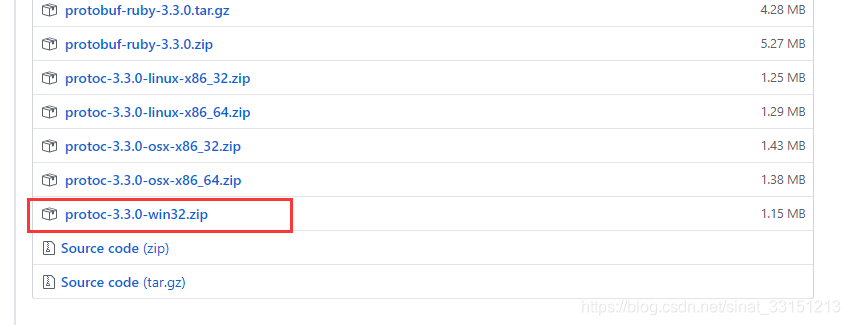Protocol Buffers(又名protobuf)是Google开发的一种与语言无关,平台无关的可扩展机制,用于序列化结构化数据。相比较XML和JSON格式,protobuf更小、更快、更便捷。https://github.com/protocolbuffers/protobuf
准备工作:
1.官方文档,可以看下protobuf的相关介绍
2.在GitHub下载protobuf并安装
注:下载protobuf版本,根据你当前的系统下载。下图是我下载的版本,我的电脑系统是win10-64位的,下载win32.zip就可以。另外,如果通过protobuf生成文件后,类文件里面引用报错了,重新下载一个版本试试。我开始用的最新的protobuf版本,后来下载这个3.3.0版本就没问题了。可能是gradle依赖版本问题。
下载完成后,直接解压。然后将protobuf添加到环境变量里面。
gradle引用依赖
我用的是gradle,如果没有的话,还需要安装一下gradle,或者用maven也可以。
build.gradle
plugins {
id 'java'
}
group 'com.hll'
version '1.0-SNAPSHOT'
sourceCompatibility = 1.8
repositories {
mavenCentral()
}
dependencies {
compile (
"io.netty:netty-all:4.1.9.Final",
"com.google.protobuf:protobuf-java:3.3.1",
"com.google.protobuf:protobuf-java-util:3.3.1"
)
}
tasks.withType(JavaCompile) {
options.encoding = 'UTF-8'
}
创建protobuf文件
protobuf文件是以proto为后缀的,我们在这里面写protobuf相关的代码
Student.proto
//指定语法是proto2
syntax = "proto2";
package com.hll.protobuf;
//文件选项,SPEED是加快文件的解析速度,不写的话默认就是SPEED,另外还有CODE_SIZE,LITE_RUNTIME
option optimize_for = SPEED;
//输出文件路径
option java_package = "com.hll.netty.sixthexample";
//输出文件名
option java_outer_classname = "StudentInfo";
message Student {
required string name = 1;
optional int32 age = 2;
optional string address = 3;
}
通过protoc生成类文件
打开idea的Termainal,通过protoc命令来生成文件.
#这里面的文件路径和文件名根据自己的项目写
protoc --java_out=src/main/java src/protobuf/Student.proto
执行后,没有错误的话,我们在项目中就可以看到生成好的文件了。注意:这个生成的文件不要进行任何的修改。
创建服务端和客户端
protobuf的配置及文件创建完成之后,创建一个服务端和客户端。
服务端
TestServer.java
public class TestServer {
public static void main(String[] args) throws Exception {
EventLoopGroup bossGroup = new NioEventLoopGroup();
EventLoopGroup workerGroup = new NioEventLoopGroup();
try {
ServerBootstrap bootstrap = new ServerBootstrap();
bootstrap.group(bossGroup, workerGroup)
.channel(NioServerSocketChannel.class)
.handler(new LoggingHandler(LogLevel.INFO))
.childHandler(new TestServerInitializer());
ChannelFuture future = bootstrap.bind(8899).sync();
future.channel().closeFuture().sync();
} finally {
bossGroup.shutdownGracefully();
workerGroup.shutdownGracefully();
}
}
}
TestServerInitializer.java
public class TestServerInitializer extends ChannelInitializer<SocketChannel> {
@Override
protected void initChannel(SocketChannel ch) throws Exception {
ChannelPipeline pipeline = ch.pipeline();
//netty对protobuf提供了主要有四个handler处理器
pipeline.addLast("protobufVarint32FrameDecoder", new ProtobufVarint32FrameDecoder());
//ProtobufDecoder类型就是我们需要转换的类的实例,这里需要转换的就是Student
pipeline.addLast("protobufDecoder", new ProtobufDecoder(StudentInfo.Student.getDefaultInstance()));
pipeline.addLast("protobufVarint32LengthFieldPrepender", new ProtobufVarint32LengthFieldPrepender());
pipeline.addLast("protobufEncoder", new ProtobufEncoder());
pipeline.addLast("testServerHandler", new TestServerHandler());
}
}
TestServerHandler .java
public class TestServerHandler extends SimpleChannelInboundHandler<StudentInfo.Student> {// 泛型类型Student
@Override
protected void channelRead0(ChannelHandlerContext ctx, StudentInfo.Student msg) throws Exception {
System.out.println(msg.getName());
System.out.println(msg.getAge());
System.out.println(msg.getAddress());
}
}
客户端
TestClient .java
public class TestClient {
public static void main(String[] args) throws Exception {
EventLoopGroup loopGroup = new NioEventLoopGroup();
try {
Bootstrap bootstrap = new Bootstrap();
bootstrap.group(loopGroup).channel(NioSocketChannel.class).handler(new TestClientInitializer());
ChannelFuture future = bootstrap.connect("localhost", 8899).sync();
future.channel().closeFuture().sync();
} finally {
loopGroup.shutdownGracefully();
}
}
}
TestClientInitializer.java
public class TestClientInitializer extends ChannelInitializer<SocketChannel> {
@Override
protected void initChannel(SocketChannel ch) throws Exception {
//和服务端代码一样
ChannelPipeline pipeline = ch.pipeline();
pipeline.addLast("protobufVarint32FrameDecoder", new ProtobufVarint32FrameDecoder());
pipeline.addLast("protobufDecoder", new ProtobufDecoder(StudentInfo.Student.getDefaultInstance()));
pipeline.addLast("protobufVarint32LengthFieldPrepender", new ProtobufVarint32LengthFieldPrepender());
pipeline.addLast("protobufEncoder", new ProtobufEncoder());
pipeline.addLast("testClientHandler", new TestClientHandler());
}
}
TestClientHandler .java
public class TestClientHandler extends SimpleChannelInboundHandler<StudentInfo.Student> {
@Override
protected void channelRead0(ChannelHandlerContext ctx, StudentInfo.Student msg) throws Exception {
}
@Override
public void channelActive(ChannelHandlerContext ctx) throws Exception {
//客户端创建连接之后就像服务端发送消息
StudentInfo.Student student = StudentInfo.Student.newBuilder()
.setName("张三")
.setAge(20)
.setAddress("合肥")
.build();
ctx.writeAndFlush(student);
}
}
测试
服务端和客户端完成之后,先运行服务端,再运行客户端。就会看到传递的消息数据。




